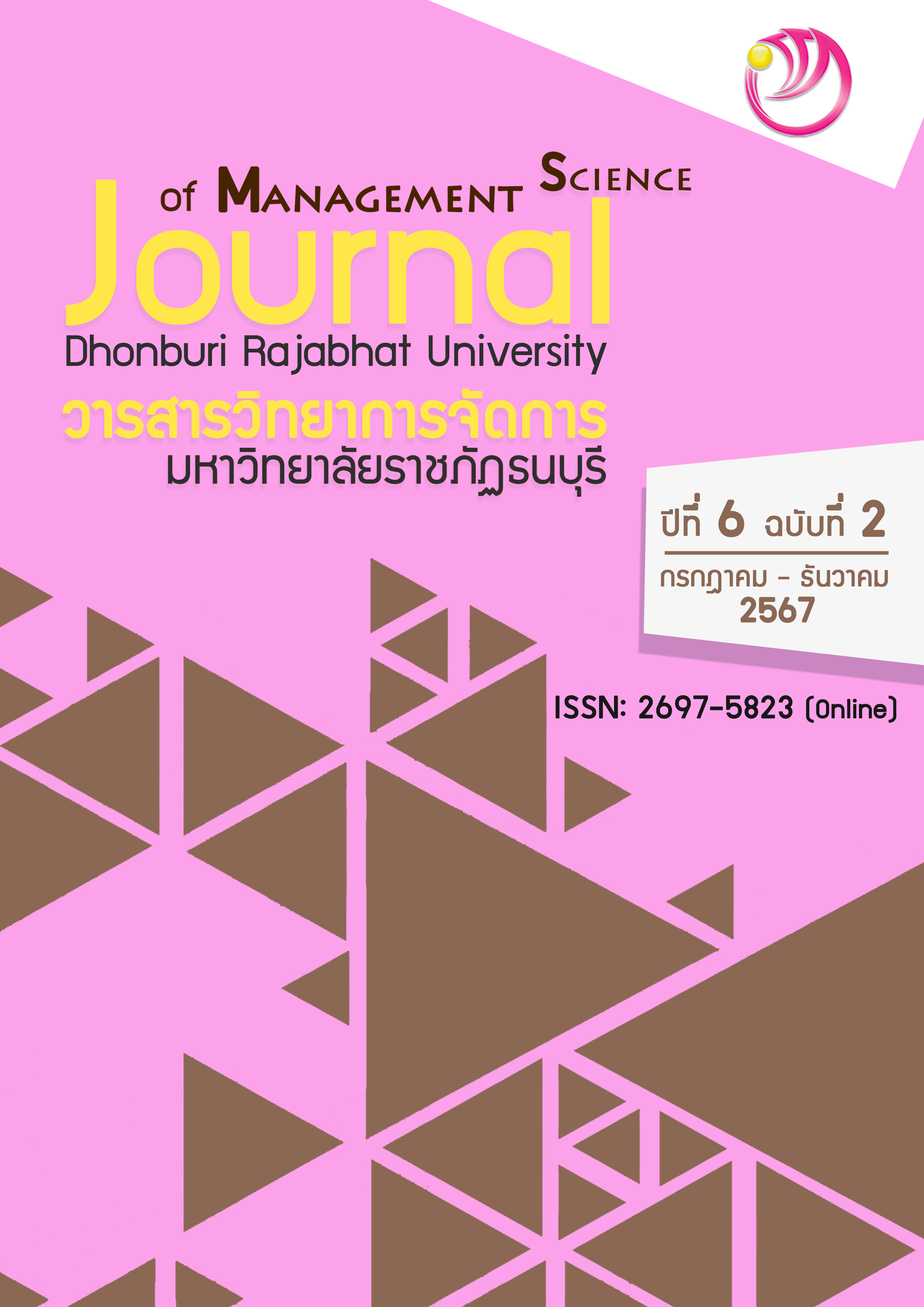Economic and Social Factors Affecting the Savings Rate of Thai Households after the COVID-19 Crisis.
Keywords:
Economic and Social Factors, The Savings Rate of Thai’s Households, The COVID-19 Pandemic, Mean Regression, Quantile RegressionAbstract
Following the COVID-19 pandemic, data on Thais' savings declined even further. It concerns household well-being and means of subsistence, including sustained economic growth. This study aims to analyze economic and social factors affecting the savings rate of Thai households after the COVID-19 pandemic. The data used came from the 2023 household economic and social survey, which included 46,090 households. The analysis employed a multiple linear regression method and utilized a quantile regression method at levels 0.25 and 0.75 to calculate the impact of household economic and social factors on the savings rates of below-average and above-average households, respectively. The study revealed that factors that have a statistically significant effect on the savings rate of households in all groups include the average monthly household income and the number of household members who work for income, which positively affect the savings rate of households. While the average monthly household expenditure and the number of children under 15 years in the household have a negative effect on the household savings rate. Therefore, the government sector should have a policy to promote financial literacy and financial management among households. There is a policy to increase employment and household income. There are measures to help reduce household expenses and the burden of the cost of having a child. These things will help households increase their savings potential.
References
กองทุนบำเหน็จบำนาญข้าราชการ. (ม.ป.ป.). การบริหารเงินสำหรับวัยเริ่มต้นทำงาน. สืบค้นจาก https://www.gpf.or.th/thai2019/2Member/main.php?page=31-3&subject=สังคมสูงวัยทำไมต้องออม&pk=382&mid=35&menu=knowledgeoom&lang=th
เดลินิวส์ออนไลน์. (2565). เปิดสถิติเงินฝากคนไทย ออมเงินมาก-น้อยแค่ไหน ‘กูรู’ แนะวางแผนสู่ความ มั่งคั่ง. สืบค้นจาก https://www.dailynews.co.th/news/1388335/
ตลาดหลักทรัพย์แห่งประเทศไทย. (2565). 4 บัญชีเงินออมและเทคนิคออมเงิน. สืบค้นจาก https://www.set.or.th/th/education-research/education/happymoney/knowledge/article/18-4-savings-accounts-and-savings-tips
ตลาดหลักทรัพย์แห่งประเทศไทย. (2562). Wealth Design เลือกสร้างความมั่งคั่งในแบบที่ใช่…สไตล์คุณ. กรุงเทพมหานคร: ตลาดหลักทรัพย์แห่งประเทศไทย.
ธนาคารแห่งประเทศไทย. (ม.ป.ป.). การออม. สืบค้นจาก https://www.bot.or.th/th/satang-story/money-plan/saving.html
นิตยา ปะอินทร์. (2562). ปัจจัยที่มีอิทธิพลต่อศักยภาพในการออมของครัวเรือนจนเปรียบเทียบกับครัวเรือนรวย. วิทยานิพนธ์วิทยาศาสตรมหาบัณฑิต สาขาวิชาสถิติประยุกต์. สถาบันบัณฑิตพัฒนบริหารศาสตร์.
สายสุณี ประดับนาค, สิริทิพ วะศินรัตน์ และนันทวรรณ บัวรา. (2566). การวิเคราะห์แบ่งกลุ่มครัวเรือนและปัจจัยที่มีอิทธิพลต่อการบริหารจัดการทางการเงินของครัวเรือนในตำบลบ้านเชี่ยน อำเภอหันคา จังหวัดชัยนาท. วารสารวิจัยราชภัฏพระนคร สาขามนุษยศาสตร์และสังคมศาสตร์. 18(2), 184-196.
สุนัยญา แดงเหม. (2565). ปัจจัยที่มีผลต่อการออมของครัวเรือนไทยในยุคเศรษฐกิจดิจิทัล. วิทยานิพนธ์เศรษฐศาสตรมหาบัณฑิต สาขาวิชาเศรษฐกิจดิจิทัล. มหาวิทยาลัยรังสิต.
สำนักงานสถิติแห่งชาติ. (2565). การสำรวจการติดตามระดับความรู้ และการเข้าถึงบริการทางการเงินของครัวเรือน พ.ศ. 2565. สืบค้นจาก https://www.nso.go.th/nsoweb/storage/survey_detail/2023/20231115075919_49757.pdf
สำนักงานกองทุนสนับสนุนการสร้างเสริมสุขภาพ. (2565). ปี 65 ไทยเข้าสู่สังคมผู้สูงอายุโดยสมบูรณ์ สสส.ผนึกภาคีผลักดันนโยบายเพื่อสุขภาวะที่ดีของผู้สูงอายุทั่วประเทศ. สืบค้นจาก https://www.thaihealth.or.th/ปี-65-ไทยเข้าสู่สังคมผู้ส/
ศศิวุฑฒิ์ วงษ์มณฑา. (2559). ผลของการเปลี่ยนแปลงทางประชากรต่อพฤติกรรมการออมของครัวเรือนในประเทศไทย. (รายงานวิจัยฉบับสมบูรณ์). ชลบุรี: มหาวิทยาลัยบูรพา.
วิชนี คุปตะวาทิน, แมน วาสนาพงษ์, พรทิพย์ ขุนดี, และรัชตา มิตรสมหวัง. (2561). สังคมสูงวัยกับโลกสมัยใหม่. Journal of Suvarnabhumi Institute of Technology (Humanities and Social Sciences). 4(Special), 444-450.
อธิพันธ์ วรรณสุริยะ. (2566). ปัจจัยที่มีผลต่อระดับการออมที่พอเพียงของครัวเรือนในกรุงเทพมหานครและปริมณฑล. วารสารการบัญชีและการจัดการ. 15(3), 14-33.
อธิพันธ์ วรรณสุริยะ. (2566). พลวัตรของรายได้ รายจ่าย เงินออมของของครัวเรือนไทย ในช่วงปี 2554-2562. วารสารการจัดการปริทัศน์. 25(1), 29-42.
อธิพันธ์ วรรณสุริยะ และสุวิมล เฮงพัฒนา. (2562). ความสามารถในการออมของครัวเรือนไทยเปรียบเทียบระหว่างแรงงานในระบบและแรงงานนอกระบบ. วารสารเศรษฐศาสตร์และกลยุทธ์การจัดการ. 6(2), 1-17.
Balcha, B. D., Feyissa, G. F., & Jekamo, D. M. (2022). Determinants of Households Saving: The Case of Shashamene Town, West Arsi Zone, Oromia, Ethiopia. Journal of Finance and Economics, 10(1), 20-28.
Hair, J. F., Black, W. C., Babin B. J., &Anderson, R. E. (2010). Multivariate Data Analysis. (7th ed.). New Jersey: Pearson Education.
Lusaya. S., &Mulunda. N. (2022). Factors Determining Household Savings in Zambia: A Logit Regression Model from the Micro-Economic Perspective. World Journal of Advanced Research and Reviews. 13(1), 520-533.
Mazengiya. N. M., Seraw. G., Melesse. B., &Belete. T. (2022). Determinants of Rural Household Saving Participation: A Case Study of Libokemkem District, North-West Ethiopia. Cogent Economics & Finance. 10(1), 1-21.
Sahudin, Z., Ridzuan, A. R., Razak, M. I. M., & Bahrudin, N. Z. (2024). Determinants of Household Savings. Advances in Social Sciences Research Journal, 11(2.2).
Sisay. K. (2023). Rural Households Saving Status and its Determinant Factors: Insight from Southwest Region of Ethiopia. Cogent Economics & Finance. 11(2), 1-18.
Wijaya, A., Zainurossalamia, S. Z., & Darma. D. C. (2020). Life-Cycle Hypothesis for Consumption Pattern: Example from Indonesia. International Journal of Advanced Science and Technology, 29(4), 4712-4720.
Downloads
Published
How to Cite
Issue
Section
License
Copyright (c) 2024 Faculty of Management Science, Dhonburi Rajabhat University

This work is licensed under a Creative Commons Attribution-NonCommercial-NoDerivatives 4.0 International License.







